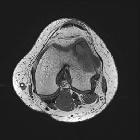Rosai-Dorfman-Erkrankung












Rosai-Dorfman disease, also known as sinus histiocytosis with massive lymphadenopathy or Rosai-Dorfman-Destombes disease, is a rare benign idiopathic proliferative disease that involves phagocytic histiocytes.
Epidemiology
The disease predominantly occurs in young adults with a mean age at presentation of 21 years. There may be a slight male predominance .
Clinical presentation
A vast majority of patients (~80%) present with painless massive cervical lymphadenopathy, with associated fever, malaise, weight loss and night sweats .
In individuals with intracranial involvement, headaches and seizures have been described and in many, no systemic manifestations are present . Additional site-specific signs and symptoms may also be present (e.g. pituitary dysfunction).
Pathology
Etiology
The exact cause is unknown but disordered immune regulation and viral infections (e.g. EBV, HHV) are thought to be involved .
Location
There is a very wide distribution. The condition can affect a multitude of organ systems which include:
- nodal involvement
- cervical lymph nodes (commonest)
- inguinal nodes
- axillary nodes
- mediastinal nodes
- para-aortic nodes
- extranodal involvement (~30% )
- lungs (~2.5%): nodules and perilymphatic interstitial thickening
- skin
- nasal cavity
- orbit: ~7%
- bone
- intracranial and spinal disease: rare
Microscopic appearance
Histologically, it is characterized by an attenuated infiltration of lymphoplasmacytic cells and histiocytes of varying sizes. The large, pale histiocytic cells contain what looks like engulfed lymphocytes ("emperipolesis") within their cellular borders.
Immunophenotype
- S100: positive
- CD11c: positive
- CD68: positive
- L1 antigen: positive
- CD1a: negative
Radiographic features
Due to the wide disease spectrum, radiographic features can be variable. Nodal involvement is appreciated as lymphadenopathy on plain film and cross-sectional imaging.
CT
- central nervous system
- hyperattenuating meningeal-based mass showing contrast enhancement
- parenchymal edema surrounding the lesion may be present
MRI
- central nervous system
- meningeal-based masses
- T1: isointense to grey matter
- T2: hypointense to grey matter
- T1 C+ (Gd): homogeneous enhancement
- meningeal-based masses
Nuclear medicine
Often shows increased uptake with Gallium scanning and increased metabolism with FDG-PET.
Treatment and prognosis
Rosai-Dorfman disease usually follows a benign and self-limiting course with treatment largely targeted at controlling local manifestations (surgical intervention) .
History and etymology
This condition was initially described by Juan Rosai and R F Dorfman in 1969.
See also
Siehe auch:
und weiter:

 Assoziationen und Differentialdiagnosen zu Rosai-Dorfman-Erkrankung:
Assoziationen und Differentialdiagnosen zu Rosai-Dorfman-Erkrankung:
